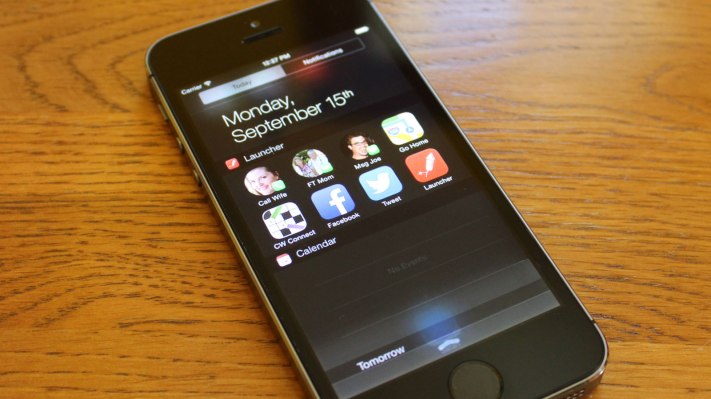With iOS 8, Apple introduced a way for mobile applications to add widgets to its Notification Center that offered snapshots of information, like today’s weather, stock quotes, headlines, and more. But one clever app called Launcher took advantage of the new functionality to turn its widget into a tool that allowed you to tap to launch other apps installed on your phone. Last fall, Apple booted the app from the App Store for unknown reasons. But starting today, Launcher has returned, nearly unchanged, indicating a slight relaxing of the rules on Apple’s side.
Apple, explains Launcher’s creator Greg Gardner, is “now okay with the concept,” he says of receiving permission to bring his app back to the iTunes App Store.
In case you missed it the first time around, the Launcher app itself offered little functionality beyond configuring its included widget. The idea was to offer a way for you to add shortcuts to your most-used applications and various tasks (e.g. like placing a phone call or posting a tweet) to the Notification Center in iOS 8.
For instance, you could add a button for calling your most-often-dialed FaceTime contact, or a shortcut for directions to your most-frequented routes, and more. The company also offered an upgrade to a paid version that removed the “Sponsored Launcher” spot, which served as a promotional tool to market other apps.
We theorized once that the Sponsored spot may have contributed to the App Store ban, but what it really came down to was Apple’s policies around how it intended Notification Center widgets to be used. At the time of Launcher’s ban, it seems Apple hadn’t anticipated some of the more innovative use cases for its widget technology.
That problem reared its head again when Apple rejected, then later approved, calculator widgets like the popular one from PCalc, for example.
[gallery ids="1133977,1133976,1133979,1133980,1133981"]
According to Gardner, the new version of his Launcher app basically offers the same functionality as the one Apple previously rejected. It even includes the Sponsored app, which users can pay $3.99 to remove.
Gardner explains that after being banned from the App Store, he continued to test what Apple found acceptable by submitting new apps based off Launcher functionality. Most of these were also rejected, except for one called “Music Launcher” whose rejection was overturned in December and was then released in January. Apparently, this app was allowed because it didn’t actually launch other apps – it only called the MediaPlayer API to start music.
In other words, until recently, Apple still had a problem with apps that solely existed as tools to launch other apps via a widget interface.
But a few weeks ago, Gardner says he resubmitted a stripped-down version of Launcher that only allowed you to set up launchers to call, email, FaceTime and message others, which he dubbed “Contact Launcher.” It, too, was initially rejected but was later overturned after a lengthy appeals process. With that approval in hand, the developer returned to Apple and asked why Contact Launcher was allowed, but Launcher itself was not.
With the first approval setting a precedent of sorts, Apple re-reviewed Launcher and made the decision to allow it back in the App Store, too. While the app is officially slated to appear live in all markets on Thursday, it has popped up early in Japan, Korea, and China just before midnight their time. Because of the press attention it had previously received, the app has now been downloaded by a number of users in the regions where it’s available, prompting Gardner to have to disclose its public debut a day earlier than he anticipated.
Gardner says he doesn’t really know why Apple changed its mind, but speculates that, based on what an App Store reviewer once said, the company starts off with a more conservative stance regarding how new iOS features are to be used, and then loosens up its policies over time.
Launcher really was a handy tool for getting to your most-used apps and tasks quickly, and it will be nice to put it to use again. When Launcher goes live in your market, you’ll be able to download it from the homepage here or directly from the iTunes App Store here. The new version also now allows paying users to make the icons smaller and hide the labels to make the widget more compact, the company notes.
